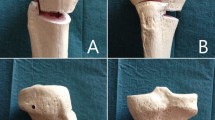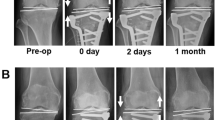Abstract
Purpose
The aim of the present study was to examine changes in radiological variables in a prospective randomized study comparing opening wedge (OW) and closing wedge (CW) techniques of high tibial osteotomy (HTO). Our hypothesis was that there would be no differences in joint line angles or correction accuracy between the two groups, that patellar height would increase after CW HTO and decrease after OW HTO, and that leg length and posterior tibial slope would decrease after CW HTO and increase after OW HTO.
Methods
Radiological data were collected from 70 patients participating in an ongoing prospective randomized clinical trial comparing OW and CW HTOs. Digital standing hip–knee–ankle (HKA) radiographs as well as lateral radiographs in 30° of flexion were obtained preoperatively and at 6 months for each patient. Joint line angles, HKA angle, leg length, Insall–Salvati index, Miura–Kawamura index and posterior tibial slope were measured using medical planning software. The complete preoperative radiological examinations of the first 50 patients were used in a study of intra- and inter-rater reliability of the measurements.
Results
The mean posterior slope was reduced by 2.5° in CW HTO, whereas it remained unchanged in OW HTO (p < 0.001). Mean leg length decreased 5.7 mm in CW HTO and increased 3.1 mm in OW HTO (p < 0.001). Changes in joint line angles, patellar height indexes and the correction accuracy showed no significant differences comparing the two techniques. Frontal plane reliability measurement intra- and inter-rater intraclass correlation coefficient (ICC) varied from 0.81 to 0.99. Sagittal plane intra- and inter-rater ICC varied from 0.60 to 0.87. Posterior tibial slope intra- and inter-rater ICC showed the lowest values (0.70 and 0.60, respectively) corresponding to a smallest real difference of 4.5° and 5.5°, respectively.
Conclusions
Posterior tibial slope and leg length changes were significantly different in CW compared to OW HTOs. We recommend that possible alterations in tibial slope and leg length are considered when the technique of HTO is to be chosen. Landmark-based medical planning software shows good reliability and can be used in preoperative planning and postoperative evaluations of HTOs.
Level of evidence
I.


Similar content being viewed by others
References
Amzallag J, Pujol N, Maqdes A, Beaufils P, Judet T, Catonne Y (2013) Patellar height modification after high tibial osteotomy by either medial opening-wedge or lateral closing-wedge osteotomies. Knee Surg Sports Traumatol Arthrosc 21:255–259
Babis GC, An K-N, Chao EYS, Larson DR, Rand JA, Sim FH (2008) Upper tibia osteotomy: long term results—realignment analysis using OASIS computer software. J Orthop Sci Springer 13:328–334
Babis GC, An K-N, Chao EYS, Rand JA, Sim FH (2002) Double level osteotomy of the knee: a method to retain joint-line obliquity. Clinical results. J Bone Joint Surg Am 84-A:1380–1388
Bae DK, Song SJ, Kim HJ, Seo JW (2013) Change in limb length after high tibial osteotomy using computer-assisted surgery: a comparative study of closed- and open-wedge osteotomies. Knee Surg Sports Traumatol Arthrosc 21:120–126
Bito H, Takeuchi R, Kumagai K, Aratake M, Saito I, Hayashi R, Sasaki Y, Saito T (2010) Opening wedge high tibial osteotomy affects both the lateral patellar tilt and patellar height. Knee Surg Sports Traumatol Arthrosc 18:955–960
Bland JM, Altman DG (1986) Statistical methods for assessing agreement between two methods of clinical measurement. Lancet 1:307–310
Brouwer GM, van Tol AW, Bergink AP, Belo JN, Bernsen RMD, Reijman M, Pols HAP, Bierma-Zeinstra SMA (2007) Association between valgus and varus alignment and the development and progression of radiographic osteoarthritis of the knee. Arthritis Rheum 56:1204–1211
Brouwer RW, Bierma-Zeinstra SMA, van Koeveringe AJ, Verhaar JAN (2005) Patellar height and the inclination of the tibial plateau after high tibial osteotomy. The open versus the closed-wedge technique. J Bone Joint Surg Br 87:1227–1232
Brouwer RW, Bierma-Zeinstra SMA, van Raaij TM, Verhaar JAN (2006) Osteotomy for medial compartment arthritis of the knee using a closing wedge or an opening wedge controlled by a Puddu plate. A one-year randomised, controlled study. J Bone Joint Surg Br 88:1454–1459
Chae DJ, Shetty GM, Lee DB, Choi HW, Han SB, Nha KW (2008) Tibial slope and patellar height after opening wedge high tibia osteotomy using autologous tricortical iliac bone graft. Knee 15:128–133
Coventry MB (1987) Proximal tibial varus osteotomy for osteoarthritis of the lateral compartment of the knee. J Bone Joint Surg Am 69:32–38
Coventry MB, Ilstrup DM, Wallrichs SL (1993) Proximal tibial osteotomy. A critical long-term study of eighty-seven cases. J Bone Joint Surg Am 75:196–201
Ducat A, Sariali E, Lebel B, Mertl P, Hernigou P, Flecher X, Zayni R, Bonnin M, Jalil R, Amzallag J, Rosset P, Servien E, Gaudot F, Judet T, Catonne Y (2012) Posterior tibial slope changes after opening- and closing-wedge high tibial osteotomy: a comparative prospective multicenter study. Orthop Traumatol Surg Res 98:68–74
Dugdale TW, Noyes FR, Styer D (1992) Preoperative planning for high tibial osteotomy. The effect of lateral tibiofemoral separation and tibiofemoral length. Clin Orthop Relat Res 274:248–264
Duivenvoorden T, Brouwer RW, Baan A, Bos PK, Reijman M, Bierma-Zeinstra SMA, Verhaar JAN (2014) Comparison of closing-wedge and opening-wedge high tibial osteotomy for medial compartment osteoarthritis of the knee: a randomized controlled trial with a six-year follow-up. J Bone Joint Surg Am 96:1425–1432
El-Azab H, Glabgly P, Paul J, Imhoff AB, Hinterwimmer S (2010) Patellar height and posterior tibial slope after open- and closed-wedge high tibial osteotomy: a radiological study on 100 patients. Am J Sports Med 38:323–329
Gaasbeek R, Welsing R, Barink M, Verdonschot N, van Kampen A (2007) The influence of open and closed high tibial osteotomy on dynamic patellar tracking: a biomechanical study. Knee Surg Sports Traumatol Arthrosc 15:978–984
Gaasbeek RDA, Nicolaas L, Rijnberg WJ, van Loon CJM, van Kampen A (2010) Correction accuracy and collateral laxity in open versus closed wedge high tibial osteotomy. A one-year randomised controlled study. Int Orthop 34:201–207
Gurney B (2002) Leg length discrepancy. Gait Posture 15:195–206
Hankemeier S, Mommsen P, Krettek C, Jagodzinski M, Brand J, Meyer C, Meller R (2010) Accuracy of high tibial osteotomy: comparison between open- and closed-wedge technique. Knee Surg Sports Traumatol Arthrosc 18:1328–1333
Hinterwimmer S, Beitzel K, Paul J, Kirchhoff C, Sauerschnig M, von Eisenhart-Rothe R, Imhoff AB (2011) Control of posterior tibial slope and patellar height in open-wedge valgus high tibial osteotomy. Am J Sports Med 39:851–856
Hoell S, Suttmoeller J, Stoll V, Fuchs S, Gosheger G (2005) The high tibial osteotomy, open versus closed wedge, a comparison of methods in 108 patients. Arch Orthop Trauma Surg 125:638–643
Insall J, Salvati E (1971) Patella position in the normal knee joint. Radiology 101:101–104
Kaper BP, Bourne RB, Rorabeck CH, MacDonald SJ (2001) Patellar infera after high tibial osteotomy. J Arthroplasty 16:168–173
Kesmezacar H, Erginer R, Ogut T, Seyahi A, Babacan M, Tenekecioglu Y (2005) Evaluation of patellar height and measurement methods after valgus high tibial osteotomy. Knee Surg Sports Traumatol Arthrosc 13:539–544
Landis JR, Koch GG (1977) The measurement of observer agreement for categorical data. Biometrics 33:159–174
LaPrade RF, Oro FB, Ziegler CG, Wijdicks CA, Walsh MP (2010) Patellar height and tibial slope after opening-wedge proximal tibial osteotomy: a prospective study. Am J Sports Med 38:160–170
Luites JWH, Brinkman J-M, Wymenga AB, van Heerwaarden RJ (2009) Fixation stability of opening- versus closing-wedge high tibial osteotomy: a randomised clinical trial using radiostereometry. J Bone Joint Surg Br 91:1459–1465
Magnussen RA, Lustig S, Demey G, Neyret P, Servien E (2011) The effect of medial opening and lateral closing high tibial osteotomy on leg length. Am J Sports Med 39:1900–1905
Miura H, Kawamura H, Nagamine R, Urabe K, Iwamoto Y (1997) Is patellar height really lower after high tibial osteotomy? Fukuoka Igaku Zasshi 88:261–266
Paley D (2002) Principles of deformity correction. Springer, Berlin
Roos EM, Lohmander LS (2003) The Knee injury and Osteoarthritis Outcome Score (KOOS): from joint injury to osteoarthritis. Health Qual Life Outcomes 1:64
Savarese E, Bisicchia S, Romeo R, Amendola A (2011) Role of high tibial osteotomy in chronic injuries of posterior cruciate ligament and posterolateral corner. J Orthop Traumatol 12:1–17
Schiedel F, Probst A, Buller TC, Rödl R (2009) The postoperative patella height: a comparison of additive and subtractive high tibial osteotomy in correcting the genu varum. Arch Orthop Trauma Surg 129:1271–1277
Schröter S, Ihle C, Mueller J, Lobenhoffer P, Stöckle U, van Heerwaarden R (2013) Digital planning of high tibial osteotomy. Interrater reliability by using two different software. Knee Surg Sports Traumatol Arthrosc 21:189–196
Schulz KF, Grimes DA (2002) Generation of allocation sequences in randomised trials: chance, not choice. Lancet 359:515–519
Shelburne KB, Kim H-J, Sterett WI, Pandy MG (2011) Effect of posterior tibial slope on knee biomechanics during functional activity. J Orthop Res 29:223–231
Shoji H, Insall J (1973) High tibial osteotomy for osteoarthritis of the knee with valgus deformity. J Bone Joint Surg Am 55:963–973
Sled EA, Sheehy LM, Felson DT, Costigan PA, Lam M, Cooke TDV (2011) Reliability of lower limb alignment measures using an established landmark-based method with a customized computer software program. Rheumatol Int 31:71–77
Smith JO, Wilson AJ, Thomas NP (2013) Osteotomy around the knee: evolution, principles and results. Knee Surg Sports Traumatol Arthrosc 21:3–22
Spahn G (2004) Complications in high tibial (medial opening wedge) osteotomy. Arch Orthop Trauma Surg 124:649–653
Webb JM, Salmon LJ, Leclerc E, Pinczewski LA, Roe JP (2013) Posterior tibial slope and further anterior cruciate ligament injuries in the anterior cruciate ligament-reconstructed patient. Am J Sports Med 41:2800–2804
Author information
Authors and Affiliations
Corresponding author
Ethics declarations
Conflict of interest
The authors declare that they have no conflict of interest. All authors disclose any financial or personal relationship with other people or organizations. The presentation of the issue is independent.
Rights and permissions
About this article
Cite this article
Nerhus, T.K., Ekeland, A., Solberg, G. et al. Radiological outcomes in a randomized trial comparing opening wedge and closing wedge techniques of high tibial osteotomy. Knee Surg Sports Traumatol Arthrosc 25, 910–917 (2017). https://doi.org/10.1007/s00167-015-3817-z
Received:
Accepted:
Published:
Issue Date:
DOI: https://doi.org/10.1007/s00167-015-3817-z




